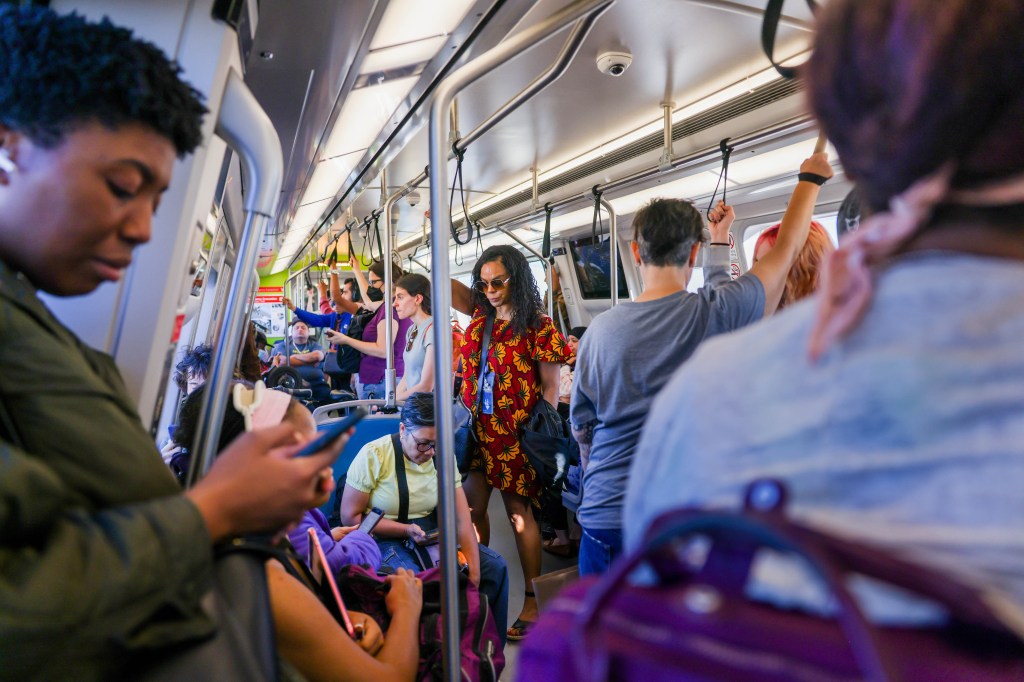Passenger numbers on Bay Area public transit are beginning to bounce back from pandemic-era lows, but some agencies are still struggling with a lack of riders and revenue, raising more concerns about long-term financial sustainability.
The COVID-19 lockdowns starting in 2020 hit public transit hard as buses and trains ran nearly empty while many people worked from home and avoided social, entertainment and recreational events. Nationwide, ridership dropped by 30% during the pandemic, and some Bay Area agencies were hit much harder.
Pre-pandemic, BART relied on passenger fares to cover roughly 60% of its operating costs, leaning less on financial aid from regional, state and federal governments. Now, with a nearly 60% reduction in ridership, it’s facing a $35 million budget shortfall in the 2026 fiscal year.
But for three days last week, BART set post-pandemic records with more than 224,000 exiting the fare gates, the highest number since March of 2020 when COVID-19 lockdowns began. Other Bay Area transit agencies saw records of their own over this month and over the summer.
BART officials credited higher passenger counts in part to the Dreamforce conference in San Francisco, the final Oakland A’s home games, concerts and community events, including Oakland Pride and the Lafayette Art & Wine Festival.
“While our ridership numbers have yet to recover to pre-pandemic levels, these high ridership days are proof that our work to improve the rider experience” is working, BART General Manager Bob Powers said in a statement.
While BART is still at just 43% of pre-pandemic ridership, the transit agency saw a 7% jump in ridership in September, compared to the same month last year.
“With remote work trends shifting, it’s encouraging to see numbers go up. And BART isn’t just for work. We’ve seen more people riding the system to fun events and experiences,’’ BART spokesperson Alicia Trost said.

A 2023 Bay Area Council survey of Bay Area employers found that 64% of respondents estimated that their employees were coming into the office at least three days a week. That’s a slight increase from 53% in November of 2022.
But that could be changing.
Just last week, Amazon, which employs thousands of people in the Bay Area, told employees that they will be expected to come into the office five days a week starting in January, up from three days.

“Others are likely to follow in that trend, and that is going to increase public transportation ridership,’’ said Joshua Schank, a research associate at the Mineta Transportation Institute in San Jose.
Transit ridership bumps aren’t limited to weekdays.
A spokesperson for the Santa Clara Valley Transportation Authority, known as VTA, said many of the agency’s weekend routes have ridership that is at or exceeding what it saw before the pandemic.
VTA said it notched 10 days of 100,000 plus riders in September, something that hadn’t happened since March 2020.
“This is mainly due to school ridership, Levi’s Stadium events, more workers and more people using the system in off-peak hours, such as midday, evening, and on weekends,” the spokesperson, Marina Chakmakjian, said in an email.
Current ridership is 82% of pre-pandemic levels, which is actually a better recovery in ridership than public transportation has seen nationally.
The American Public Transportation Association trends dashboard shows that U.S. public transportation ridership has fluctuated between 73% and 79% of 2019 levels.
In the most recent fiscal year ending in June, AC Transit, the Oakland-based bus service, reported a total ridership of 39.3 million, which is 74% of the pre-pandemic annual ridership, according to spokesperson Robert Lyles.
“Despite many Bay Area employers continuing with remote work, a growing number of worksites have adopted hybrid schedules, leading to more workers returning to AC Transit for their daily commutes,’’ Lyles said in an email.
At the end of August, its average weekday ridership was 133,000, reflecting a 4% bump compared to one year earlier.
On the Peninsula, SamTrans is leading the way for the Bay Area when it comes to ridership rebound. A spokesperson said one of the reasons is that bus riders, such as youth, disabled people and seniors, have few other transit options. Ridership for SamTrans is at nearly 100% of pre-pandemic levels.
Caltrain, however, despite recent complete electrification that allows for more frequent service, still lags behind at roughly 38% of pre-pandemic levels, according to the agency.
“Caltrain ridership was heavily impacted by COVID’s impact on 9-to-5 commuters, but we’ve been growing slowly and steadily since then by reaching out to a wider population of riders,” said spokesperson Dan Lieberman.
In San Francisco, Muni reports that since the pandemic, ridership has bounced back faster on core Muni Forward corridors where the agency has made the greatest investments, such as longer walking times for pedestrians, over the past decade.
Since 2020, the San Francisco Metropolitan Transportation Agency has added more than 22 miles of new or upgraded transit lanes — the fastest expansion of transit improvements in San Francisco’s history.

















































